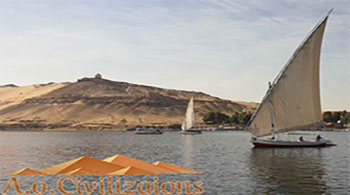The Nile River and the Emergence of the Ancient Egyptian Civilization
The Great Nile River is considered one of the most important factors that helped the emergence of ancient Egyptian civilization, as it had the greatest impact in the formation of the valley land and its preparation to be a cradle for the stability of the ancient Egyptian person and the formation of a large and authentic civilization.
The Nile River and its sources:
The Nile River is one of the largest rivers in the world in terms of length, with a length of 6671 meters and heading in terms of spring and mouth from south to north, where it passes over several different and diverse regions and connects between them. The low equatorial region then passes through the mountain basin and the semi-equatorial climate of the mountain basin, and after that it receives some sources located in the Abyssinia region, where these Ethiopian headwaters come from a semi-seasonal region and then pass through Sudan, which represents a free-standing climatic zone.
Geological development of the Nile Rive:
It can be said that the Nile River was not always in the form we see now, but there are three branches in the first place where each of these branches is independent from the other, the first in the tropical plateau, the second in the Abyssinian Plateau, and the third in the Nubia and Egypt, and it was given to us There is a lot of research evidence for the reasoning of these conclusions.
Before the Nile River was formed in its current form in the land of Egypt, there was a river called the “Old River A”, “Libyan River” and it was an old river that was located in the north of the current Fayoum region and then after that The coast of the Mediterranean, which had reached at this time to the north of Fayoum, begins, then the geological formation of the delta is completed at the beginning of the time of the Miocene. That river in particular during the Oligocene.
Sprawling valleys and vast oases:
The Valleys:
There were many tributaries of the Nile River present in the Eastern Desert, of which only the traces of its courses in the valleys were left. These tributaries dried up in the ancient Stone Age. The Nile River took its current course almost at the time of the Miocene and had several tributaries in the Eastern Desert and the Old Stone Age did not come on Egypt until these tributaries dried up, then the Gulf of Suez separated from the Mediterranean Sea, the Gulf of Aqaba shrank and the Fayoum depression appeared, as a branch of the Nile walked to that oasis-like low, and the change of some natural factors led to the drying of a branch of the offspring that had been traveling in the Western Desert since The time of the Mucin remained until the end of the Paleocene period.
Among the most important places of ancient valleys used by the ancient Egyptian man and took advantage of the natural resources in it ( Wade Hamm mat, Wade Alaqi, Wade Al Hudi, Wade Al Maghara, Wade Al Natroun ).
Oases:
There are not few oases in the Sinai desert and in the Eastern Desert, but the largest number is found in the Western Desert and abundant in it and originally there were seven oases, but now there are only five oases, namely (the marine, Kharga, Dakhla, Farafra, Siwa).
Its lands were suitable for cultivation and abundant with good things, and that is why ancient Egyptian people used them to make good use of civilization since ancient times.
Deserts:
Deserts were in ancient times, especially in the ancient stone age, the first stage of human activity in this part of Africa. After the end of the rainy period and the prolonged drought, many residents left these lands and then moved to the valley and had to reside on the banks of the valley.
Deserts have completely dried up in historical times and their population has decreased due to droughts, except for some mobile tribes in the Eastern Desert and in the north of the Western Desert, and some of the settled residents of the oases.

